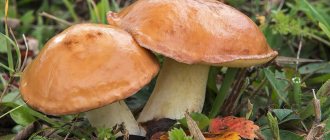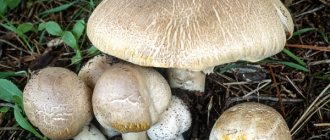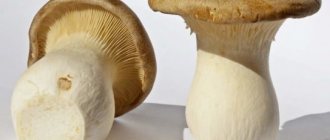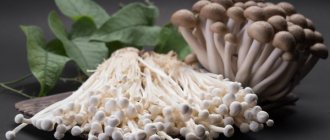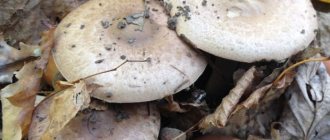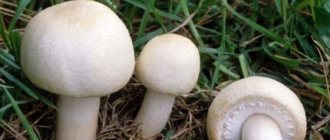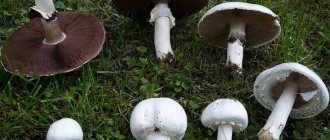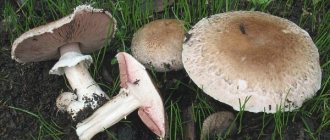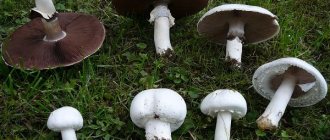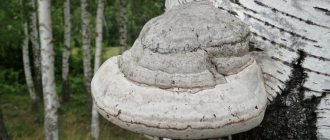Do you know where champignons grow? Today we will tell you in detail about the origin and places of growth of these interesting mushrooms, which are so popular among gourmets.
General information about the mushroom
Translated from French it means “mushroom”. Champignons belong to the Agarikov family, i.e. lamellar. The genus includes both edible and inedible mushrooms.
The delicacy became widespread thanks to the French King Louis XIV, a keen connoisseur of mushroom dishes.
Interesting Facts
We can talk endlessly about the benefits of a representative of the lamellar family, but here are the most interesting facts:
- Champignons were one of the first mushrooms to produce crops outside of their natural environment.
- This type of mushroom is often called “second meat” - there is so much protein in them!
- Can I eat fresh champignons?
Some may find the question absurd. However, this is the only mushroom that can be eaten raw!
hat
The mushroom cap is massive, fleshy, dense. The surface is fibrous or scaly. With age, the cap begins to unfold and gradually becomes flat. Its color ranges from white to brown. The most famous varieties of champignons have a classic white color.
Due to the content of a large amount of vitamins and microelements, mushroom caps are highly valued.
Leg
Smooth, strong, cylindrical. Its height is up to 15 cm. It often widens at the base. Available in single or double layer rings.
The flesh is white at the break, but when exposed to air it begins to turn slightly yellow.
Spore-bearing layer
It is represented by free plates that change color depending on age. Young mushrooms have white plates, adults have pinkish ones. The leaves of old champignons are olive-black.
The plates of one mushroom contain up to 16 billion spores! And each one can give life to a new mycelium.
Pulp
Thin, dense. It has an anise smell and a nutty taste. Painted in shades of white. When exposed to oxygen, it can change color to yellow or red.
Description
The word "Champignon" translated from French means "mushroom".
Hat:
- diameter – from 7 to 17 cm;
- shape – regular, round, with a characteristic convexity;
- color grey-brown;
- membranes (hymenophore plates) are thin, transparent, densely located;
- spores are gray-black.
Leg:
- height – 9-11 cm;
- diameter about 2 cm;
- shape - cylinder;
- the ring is thin-membrane.
Pulp:
- the structure is dense;
- White color;
- smell characteristic of champignon.
Changes during the growth period
During the process of intensive growth, the leg quickly thickens, the structure becomes denser, and the upper skin acquires a pinkish or yellowish tint.
When the cap reaches biological maturity, it becomes rough and hard. The plates gradually acquire a red-brown color.
Meadow champignon never grows alone - its biology excludes this. It forms groups in the form of rings, which are also called “forest bracelet” or “witch rings”. Lands cultivated by humans are the most suitable habitat for pecheritsa (the popular name for meadow grassers)
Benefits of mushroom
The benefits of champignons for the body
colossal. The following facts can be cited as proof:
- One kg of champignons contains approximately the same amount of protein as one liter of cow's milk. And this protein is well absorbed by the body - on 80%.
- Mushroom protein contains 18 amino acids! Some of them can only come from food. Among amino acids, lysine especially stands out for its positive effect on mental abilities.
- Champignon fats contain lecithin, which strengthens the nervous system.
- The calorie content of champignon mushrooms
is minimal.
100 g contains 27 kcal . In the modern world there is a continuous pursuit of weight loss and therefore such a mushroom would be an excellent product on the menu. It also contains little sodium and is therefore recommended on a salt-free diet. - Champignons contain vitamins A, C, D. For example, such vitamins are not found in green plants.
- The phosphorus content gives these mushrooms the right to compete with fish and seafood.
- In terms of potassium content, champignons are ahead of many vegetables.
They also contain a lot of calcium, iron, selenium, zinc...
Danger from the mushroom
Champignons are contraindicated for the following categories of people:
- with chronic diseases of the kidneys, liver, stomach;
- cancer patients - a high content of folic acid can promote the proliferation of bad cells;
- children of preschool age.
In addition, old mushrooms may contain alkaloids that cause digestive and circulatory disorders. Therefore, it is recommended to collect only young mushrooms - those with caps that have not yet opened or those that do not have brown plates on the back of the cap.
It is no secret that in the numerous genus of these mushrooms there are also poisonous “doubles”. Although the “forest delicacy” has been known for a long time, poisoning is not uncommon. It is very easy to confuse a poisonous mushroom with one that is eaten.
Treatment for poisoning
After hospitalization, the patient undergoes detoxification. This can be an enema, gastric lavage or hemodialysis. The choice of treatment method depends on how much of the dangerous product the patient ate.
Later, the patient’s water and electrolyte balance is restored or an IV is placed. The victim must also adhere to a special diet:
- Avoid eating fatty, spicy and smoked foods;
- eat only boiled food;
- Finely chop vegetables and fruits.
When providing first aid, you should not induce vomiting in children under 3 years of age and pregnant women. Also, enemas are not given to older people without the help of a doctor. The victim is prohibited from taking medications that strengthen the stomach
This is especially important when poisoning with dangerous mushrooms such as toadstool
Where do champignons grow?
There are no places where champignons would not take root!
They are found on all continents in almost every area.
Experienced mushroom pickers can tell you where champignons grow in nature
. Most often they grow outside the forest - in meadows, parks, vegetable gardens, orchards. It is easy to spot a representative of the lamellar family near human habitation. These mushrooms are especially concentrated in areas where cattle graze. No wonder! After all, champignons are saprotrophs: they like soil fertilized with manure. Mushrooms also choose dead wood and anthills.
Champignons have enormous elasticity. There have been cases when these mushrooms lifted and pierced asphalt and concrete floors of garages.
Of course, I wonder where champignons grow in Russia
.The mushroom is most common in the northern temperate zone. The forests of the Sverdlovsk region are especially famous for these mushrooms. People come here specifically for rich forest gifts.
Some species are found in mixed forests of the Amur region, Primorye and the West Siberian Plain. Field champignon is common in Crimea.
They usually grow in colonies. Therefore, novice mushroom pickers are not advised to collect single small specimens - there is a high risk of putting a poisonous “double” in the basket.
The most popular types of champignons grow in the following places:
- field - in clearings, forest edges, along roads;
- meadow - in grass thickets, gardens, parks;
- forest - the only specimen found only in the forest.
Spreading
The field champignon adapts to all climatic conditions. It is found in all regions of Russia. Unlike other species, it does not like to be near trees, but there is an exception - spruce or pine.
Favorite localization locations (they are easiest to find):
- forest glades and meadows, that is, places with a large concentration of herbal plants;
- roadsides;
- areas with cleared forest;
- parks, alleys and gardens;
- pastures;
- near the nettle thickets.
The mushroom grows in different ways - alone, in groups, with the formation of ruts or arcs.
When do champignons appear?
Champignons prefer moderate rains. Their body is close to the surface of the earth. Therefore, the mycelium moisturizes very quickly and within a few days young mushrooms appear. Can be collected 3-4 days after rain. The lifespan of the mushroom is short, so after 2 weeks you should not fill the basket with old specimens.
They do not appear simultaneously in different regions:
- In the southern regions - in early spring - in April, as soon as the sun begins to get hot. A prerequisite for this is humidity and warmth.
- In the northern regions - in July-August. Incredibly, field champignon can be found even during frosts!
Their peculiarity is that they grow every 2 weeks. There will always be a harvest!
Of course, it’s easier to buy champignons in the store, because they are sold throughout the year. But nothing can replace the “silent hunt”!
Virulence
The inedible champignon actively absorbs toxic substances from the soil. Consumption of such mushrooms leads to severe intoxication.
Toxoids block the production of deoxyribonucleic acid, causing healthy cells to die. This affects the kidneys, intestines and liver the most. A large portion of mushrooms eaten can be fatal.
Symptoms of poisoning
At the first symptoms of poisoning, call an ambulance
The first sign of poisoning is vomiting and stomach upset. These symptoms appear within 2-3 hours. Later, stomach colic appears. Similar symptoms are caused by toadstool and poisonous meadow mushrooms.
There are several stages of champignon poisoning. Their description:
- Spasmodic pain appears in the abdomen, body temperature rises. Later, diarrhea begins.
- The person feels a slight improvement in health, but toxic substances continue to affect the liver and kidneys. Analyzes confirm this. Remission lasts 1-2 days.
- At this stage, damage to internal organs reaches its peak. Liver and kidney failure begins.
In case of poisoning with false champignons, it is necessary to call an ambulance at the first stage of poisoning
Before her arrival, it is important to remove toxins from the body.
Description of first aid:
- drink 1 liter of a weak solution of potassium permanganate and induce vomiting to rinse the stomach;
- take sorbents at the rate of 1 g per 1 kg of patient weight;
- a warm heating pad is placed on the stomach and legs: this helps to avoid circulatory problems;
- drink strong tea or warm water.
Edible types of champignons
Types of champignons
amaze with their diversity - there are more than
60 ! They are divided into artificially cultivated and wild champignons
.
The most common champignons in nature are:
- ordinary (meadow);
- field (sidewalk);
- forest;
- crooked;
- steam;
- Bernard's mushroom;
- fine-scaled (Benesha).
Common champignon (meadow)
It is also called “petseritsa”.
The size of the cap is on average about 10 cm. The shape of the cap is spherical. A mature mushroom is hemispherical. The old one is prostrate and convex. The color of the “cap” is white or brownish.
The leg is even, smooth, thickened at the base. The ring is covered with a cap.
When cut, the pulp practically does not change color or turns slightly pink.
The spore-bearing layer is pink. In an old mushroom it can become almost black.
Common champignon
Proper cleaning
To prevent fresh rotting leaves from darkening, it is advisable to clean them immediately. First you need to sort out the mushrooms and throw away any rotten or moldy ones. Before cooking, be sure to wash the mushrooms completely, remove debris and bugs from under the cap.
The product should not be washed if you plan to dry it. Then remove the pests with a knife. Preparation for drying involves only cutting off the moldy parts.
Cleaning is carried out differently if you need to pickle or pickle meadow mushrooms. They are pre-soaked in warm water for 20-30 minutes.
Then the film is carefully cut off so that the cap remains intact. To separate the delicate film, you can place the fungus under running water
All that remains is to rinse the purified product.
Field champignon (sidewalk)
Quite a large mushroom. The hat is umbrella-shaped. An old mushroom literally looks like an open umbrella with drooping edges. The color of the cap is white, and the diameter is up to 20 cm.
The leg is high and cylindrical. Has a two-layer ring.
The pulp is white or yellowish.
The spore-bearing layer is dark brown.
Field champignon
Forest champignon
The cap is ovoid, grayish-brown in color, up to 15 cm in diameter. In an aged mushroom it looks like a saucer. Covered with scales.
The leg is curved, white or gray. In old age, the mushroom often has a hollow stem.
The pulp is white and immediately turns red when broken.
Forest champignon
August champignon
The cap is spherical, diameter is up to 15 cm. Color is golden, yellowish. The texture is scaly. A mature mushroom has a tubercle in the center of the cap.
The leg is rough and scaly. The remains of the “blanket” can hang almost to the ground.
The flesh turns pink when cut. In the old mushroom it is noticeably harder.
August champignon
Garden champignon
It is also called cultivated champignon, bisporus - this is the most common cultivated mushroom.
The size of the rounded cap is 4-7 cm. Color is white, cream.
The leg can be either filled or hollow.
The pulp is juicy. When cut it turns pink or red.
Garden champignon
Champignon coppice
The most elegant mushroom. It is he who is often confused with the toadstool.
The diameter of the ovoid cap is up to 10 cm. Color is from white to cream.
The leg is thin and often hollow inside.
The pulp is fragile and white. When cut it turns yellow.
Champignon coppice
Royal look
It is considered the most delicious - it resembles a porcini mushroom. The cap is much larger than that of the classic species. There are specimens up to 30 cm. That’s why it’s a royal champignon! Color – white, cream, brownish. May have brown spotting.
The leg is thick. Tapers towards the base. May be covered in spots, like a cap.
– The pulp is dense. Turns pink when cut.
Royal look
Poisonous "doubles"
Answer to the question: Are there false champignons?
, unfortunately, affirmative.
Despite the fact that people have been consuming this “forest delicacy” for a long time, how to distinguish champignons
.
You should remember which champignons you should not eat
:
- Californian;
- Meller;
- dark scaly;
- tabular;
- yellow-skinned or reddish.
Beginning mushroom pickers should definitely know what a false champignon looks like:
- the plates always remain snow-white;
- under mechanical influence, releases a yellow liquid;
- the leg is “inserted” into the root sac - volva;
- when broken, a sour smell or even the smell of phenol is felt.
These signs are more than enough to identify mushrooms that look like champignons!
Recipes and cooking rules
Champignon is such a common mushroom that there are many recipes using it. Let's look at the most universal ones.
Treatment
After picking or purchasing mushrooms, they should be processed before cooking. For this:
- washed under running water;
- wipe with a damp cloth;
- remove the top layer of skin from the cap;
- if the cut on the leg is old, then it should be updated;
- skirts and dark plates are removed;
- the damaged areas are cut off.
Washing the mushrooms
It is not necessary to clean the caps. This procedure is performed only for large mushrooms, because their skin becomes rough. If the skin is easy to move with your fingers, then it is better to remove the top layer.
You may be interested in:
What does the Crimean mountain white mushroom look like and its description (22 photos) The nature of the Crimean peninsula is so unique and the climate is unpredictable that even a professional mushroom picker…Read more…
Cooking times and methods
Store-bought champignons should be boiled for only five minutes, but wild mushrooms should be boiled for 10 minutes. If you have a multicooker, you can cook them without adding water by setting the “Stew” program for 40 minutes. The frozen product is defrosted and then boiled for 10 minutes.
Cooking process
For the salad, you need to cook them for 5 minutes with the addition of salt, black allspice, bay leaf and citric acid. If the fruits will be used to prepare soup, then boil them in lightly salted water for the same time.
How to fry champignons
To fry, the fruiting bodies do not need to be boiled first. To fry them properly, you should:
- Heat the frying pan well over medium heat;
- pour a little vegetable oil or butter;
- Place the chopped mushrooms in a container in small portions and fry, stirring regularly;
- At the end of frying, add salt and pepper to taste.
Fried champignons
The frying time should not exceed 7 minutes. You can use mushroom mass as an independent snack or include it in a wide variety of dishes.
Application in medicine
The benefits of champignons for the human body
huge:
- The fungus is used in the manufacture of antibacterial agents, for example, the antibiotic Campestrin.
- Champignons have a positive effect on carbohydrate metabolism, which is why they are recommended for patients with diabetes.
- Helps reduce cholesterol and destroy cholesterol plaques.
- Due to its expectorant effect, it is used in the treatment of bronchial asthma and bronchitis.
- The benefits of champignons for women
are determined by the fact that they prevent the appearance of wrinkles and help maintain a fresh complexion. This is a kind of elixir of youth!
Medicinal properties
Due to their rich composition, field champignons have a healing effect. They are used to make drugs. Recommended for use for the following diseases:
- diabetes;
- obesity;
- headache;
- problems with the kidneys, cardiovascular and nervous systems;
- tuberculosis;
- anemia;
- typhus;
- skin diseases;
- allergy;
- bronchitis.
Main properties of champignons:
- appetite suppression;
- acceleration of metabolism;
- improvement of visual acuity;
- normalization of unstable psyche;
- removal of cholesterol from the body;
- regeneration of damaged tissues;
- neutralization of bacteria and viruses;
- activation of the brain.
A special extract is isolated from mushrooms. It has a beneficial effect on hair growth, strengthening hair follicles and nail plates, improving the condition of the skin of the face and body. Lotions, balms, creams, serums, etc. are made from the extract. The cost of such products is high.
